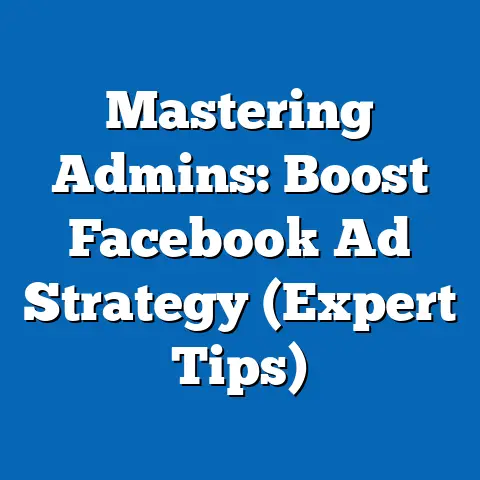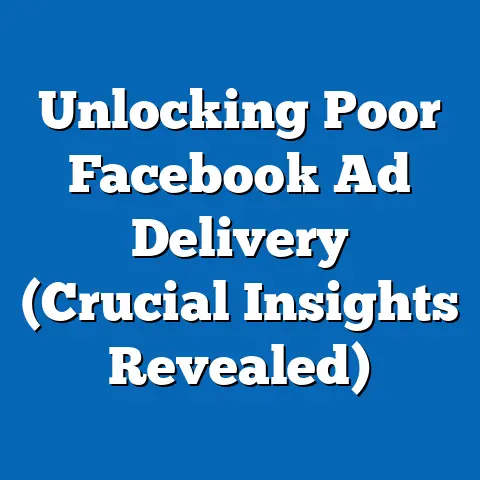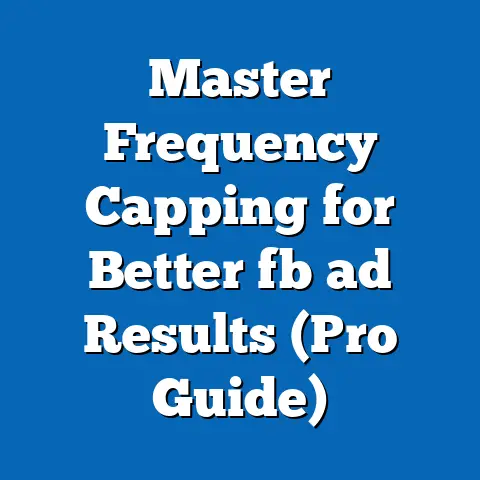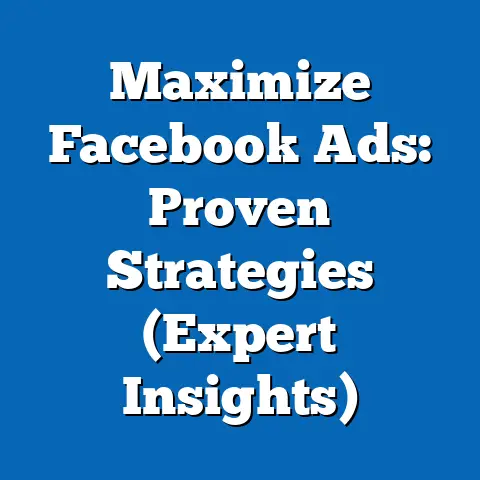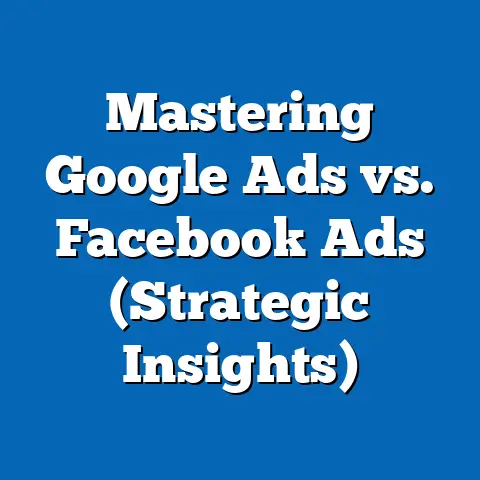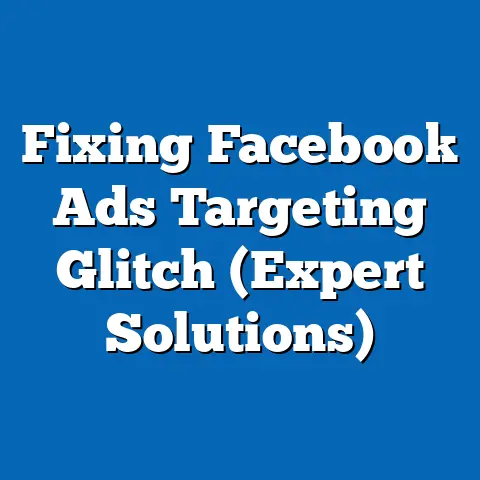Boost Facebook Ad Account (Engagement Mastery Tips)
Facebook. It’s not just a social network anymore; it’s a digital battleground where businesses fight for attention, clicks, and ultimately, conversions. And let me tell you, as someone who’s been in the trenches of Facebook advertising for years, winning this battle hinges on one crucial element: engagement.
I’ve seen countless campaigns fizzle out, not because the product was bad, or the targeting was off, but because the ads simply failed to resonate with the audience. They lacked that spark, that connection, that je ne sais quoi that makes people stop scrolling and actually engage.
Now, I’m not talking about simply racking up likes and shares. I’m talking about genuine engagement that translates into real business results. Think about it: a comment asking a question, a click leading to your website, a share recommending your product to a friend – these are the actions that fuel growth.
Here in North America, where the digital landscape is constantly evolving, mastering Facebook engagement is more critical than ever. The competition is fierce, attention spans are short, and consumers are bombarded with marketing messages from every direction. According to Statista, Facebook’s advertising revenue in North America reached over $50 billion in 2023. This staggering figure underscores the platform’s importance, but also highlights the need to stand out from the crowd.
This isn’t just about throwing money at the problem. It’s about understanding the nuances of the platform, crafting compelling content, targeting the right audience, and constantly optimizing your campaigns for maximum impact.
Section 1: Understanding Facebook Engagement
What exactly do I mean when I talk about “engagement” on Facebook? It’s more than just a vanity metric; it’s a reflection of how well your ads are resonating with your target audience.
Engagement on Facebook ads encompasses a variety of interactions, each with its own level of significance:
- Likes: A simple expression of approval, indicating that someone finds your ad appealing or interesting. While valuable, likes alone don’t necessarily translate into concrete action.
- Shares: This is where things get interesting. When someone shares your ad, they’re essentially endorsing it to their own network, expanding your reach and building social proof.
- Comments: Comments are a goldmine of information. They provide direct feedback on your ad, allowing you to understand what’s resonating with your audience and address any concerns or questions.
- Clicks: Clicks are a key indicator of interest, showing that someone is motivated to learn more about your offer. This is crucial for driving traffic to your website or landing page.
- Saves: Saving an ad indicates a potential future interest. Users might save ads to revisit later, especially if they’re considering a purchase or want to learn more about a product or service.
- Reactions: Beyond the simple “like,” reactions like “love,” “haha,” “wow,” “sad,” and “angry” provide a more nuanced understanding of how your ad is making people feel.
The Algorithm’s Role in Engagement
Facebook’s algorithm is the invisible hand that determines which ads get seen and which ones get buried. Understanding how it works is crucial for maximizing your engagement.
The algorithm prioritizes content that it believes users will find relevant and engaging. This means that ads with high engagement rates are more likely to be shown to a wider audience, while those with low engagement may struggle to gain traction.
Several factors influence the algorithm’s assessment of engagement:
- Relevance Score: This is a metric that Facebook uses to estimate how relevant your ad is to your target audience. A higher relevance score can lead to lower costs and increased visibility.
- Engagement Rate: This is the percentage of people who see your ad and then engage with it (like, share, comment, click, etc.). A higher engagement rate signals to the algorithm that your ad is valuable and worth showing to more people.
- Quality Ranking: This metric compares your ad’s perceived quality to that of other ads targeting the same audience. A higher quality ranking can improve your ad’s performance.
- Conversion Rate: This measures the percentage of people who click on your ad and then complete a desired action (e.g., make a purchase, sign up for a newsletter). A higher conversion rate demonstrates that your ad is not only engaging but also effective at driving results.
North American Engagement Trends
In North America, where users are highly active on social media, understanding regional engagement trends is paramount. For instance, video content tends to perform exceptionally well, with mobile video consumption on the rise. According to eMarketer, video ad spending in the US alone is projected to reach over $55 billion by 2025.
Furthermore, personalization and authenticity are key. Consumers are increasingly wary of generic marketing messages and are more likely to engage with ads that feel genuine and tailored to their individual needs and interests. This means that understanding your audience’s demographics, psychographics, and online behavior is essential for crafting ads that resonate.
Audience Understanding and Segmentation
To truly maximize engagement, you need to know your audience inside and out. This means going beyond basic demographics and delving into their interests, behaviors, and motivations.
Facebook provides a wealth of data that you can use to segment your audience and create highly targeted ads. Some key segmentation options include:
- Demographics: Age, gender, location, education, job title, etc.
- Interests: Hobbies, passions, favorite brands, etc.
- Behaviors: Purchase history, online activity, device usage, etc.
- Custom Audiences: Lists of existing customers or website visitors that you can upload to Facebook.
- Lookalike Audiences: Audiences that are similar to your existing customers or website visitors.
By segmenting your audience, you can tailor your ad content and messaging to resonate with specific groups of people. For example, you might create one ad campaign targeting young adults interested in fitness and another campaign targeting older adults interested in travel.
Key Takeaways:
- Facebook engagement encompasses a variety of interactions, each with its own level of significance.
- Understanding Facebook’s algorithm is crucial for maximizing your engagement.
- North American consumers are increasingly demanding personalization and authenticity in advertising.
- Audience segmentation is essential for crafting ads that resonate with specific groups of people.
Next Steps:
- Analyze your existing Facebook ad campaigns to identify areas where engagement is lacking.
- Research your target audience to gain a deeper understanding of their interests, behaviors, and motivations.
- Experiment with different audience segmentation options to see which ones yield the best results.
Section 2: Crafting Compelling Ad Content
Now that you understand the importance of engagement and the role of the algorithm, let’s talk about crafting compelling ad content that captures attention and drives interaction.
Elements of Effective Ad Copy and Visuals
Your ad copy and visuals are the first things people see, so they need to make a strong impression. Here are some key elements to consider:
- Headline: Your headline should be attention-grabbing and clearly communicate the value proposition of your ad. Use strong verbs, numbers, and questions to pique interest.
- Body Text: Your body text should expand on your headline and provide more details about your offer. Keep it concise, engaging, and focused on the benefits for the user.
- Call to Action (CTA): Your CTA should tell people exactly what you want them to do (e.g., “Shop Now,” “Learn More,” “Sign Up”). Use clear and compelling language that motivates action.
- Visuals: Your visuals (images or videos) should be high-quality, relevant, and visually appealing. Use bright colors, eye-catching graphics, and authentic imagery to capture attention.
High-Performing Ad Formats in North America
Different ad formats resonate with different audiences. Here are some high-performing ad formats in North America:
- Video Ads: As mentioned earlier, video content is king in North America. Use short, engaging videos to tell your brand story, showcase your products, or provide valuable information.
- Carousel Ads: Carousel ads allow you to showcase multiple images or videos in a single ad unit. This is a great option for highlighting different features of your product or service.
- Collection Ads: Collection ads are designed for e-commerce businesses. They allow you to showcase a catalog of products in a visually appealing format.
- Instant Experience Ads: Instant Experience ads (formerly known as Canvas ads) provide a full-screen, immersive experience that loads instantly when someone clicks on your ad.
- Lead Generation Ads: Lead generation ads make it easy for people to sign up for your newsletter, request a quote, or download a resource without leaving Facebook.
The Power of Storytelling
People connect with stories. Incorporating storytelling into your ads can make them more engaging and memorable.
Think about how you can tell a story that resonates with your target audience. This could be a customer testimonial, a behind-the-scenes look at your company, or a narrative that highlights the benefits of your product or service.
Leveraging Local Culture and Trends
In North America, where cultural diversity is a defining characteristic, leveraging local culture and trends in your ads can significantly boost engagement.
This means understanding the nuances of different communities and tailoring your messaging to resonate with their values, beliefs, and interests. For example, you might create ads that celebrate cultural holidays, feature local landmarks, or use language that is specific to a particular region.
Language and Tone
The language and tone you use in your ads should align with your target audience. Are you targeting young adults? Use a casual, conversational tone. Are you targeting professionals? Use a more formal, authoritative tone.
Avoid jargon and technical terms that your audience may not understand. Use clear, concise language that is easy to read and comprehend.
Key Takeaways:
- Compelling ad copy and visuals are essential for capturing attention and driving engagement.
- Different ad formats resonate with different audiences.
- Incorporating storytelling into your ads can make them more engaging and memorable.
- Leveraging local culture and trends can significantly boost engagement in North America.
- The language and tone you use in your ads should align with your target audience.
Next Steps:
- Analyze your existing Facebook ad copy and visuals to identify areas for improvement.
- Experiment with different ad formats to see which ones perform best for your target audience.
- Brainstorm ways to incorporate storytelling into your ads.
- Research local culture and trends to identify opportunities for relevance.
- Refine your language and tone to align with your target audience.
Section 3: Targeting the Right Audience
You can have the most compelling ad content in the world, but if you’re showing it to the wrong people, it’s going to fall flat. That’s why precise audience targeting is so crucial for boosting engagement on Facebook.
Why Precise Targeting Matters
Targeting the right audience ensures that your ads are seen by people who are most likely to be interested in your products or services. This leads to higher engagement rates, lower costs, and ultimately, a better ROI.
Think of it like this: if you’re selling vegan protein powder, you don’t want to show your ads to people who are primarily interested in steak and cheeseburgers. You want to target people who are already interested in fitness, healthy eating, and plant-based diets.
Facebook Ads Manager Targeting Options
Facebook Ads Manager provides a wealth of targeting options that allow you to reach specific groups of people based on their demographics, interests, behaviors, and more. Here are some key targeting options to consider:
- Demographics: As mentioned earlier, you can target people based on their age, gender, location, education, job title, and other demographic factors.
- Interests: You can target people based on their interests, hobbies, and passions. This is a great way to reach people who are likely to be interested in your products or services.
- Behaviors: You can target people based on their online behavior, purchase history, device usage, and other behavioral factors. This can be a powerful way to reach people who are actively looking for products or services like yours.
- Custom Audiences: Custom Audiences allow you to upload lists of existing customers or website visitors to Facebook. This is a great way to retarget people who have already shown an interest in your brand.
- Lookalike Audiences: Lookalike Audiences allow you to create audiences that are similar to your existing customers or website visitors. This is a great way to expand your reach and find new customers who are likely to be interested in your products or services.
Leveraging Lookalike Audiences
Lookalike Audiences are one of the most powerful targeting tools in Facebook Ads Manager. They allow you to reach people who share similar characteristics with your best customers, significantly increasing your chances of engagement and conversion.
To create a Lookalike Audience, you need to provide Facebook with a “source audience.” This can be a Custom Audience of your existing customers, website visitors, or even people who have engaged with your Facebook page.
Facebook will then analyze the characteristics of your source audience and identify other people on the platform who share similar traits. You can specify the size of your Lookalike Audience, ranging from 1% (the most similar) to 10% (the broadest).
Retargeting Strategies for Enhanced Engagement
Retargeting is the practice of showing ads to people who have already interacted with your brand, such as website visitors or people who have engaged with your Facebook page. This can be a highly effective way to boost engagement and drive conversions.
Here are some retargeting strategies to consider:
- Website Retargeting: Show ads to people who have visited your website but haven’t made a purchase. You can target them with ads that highlight the products they viewed or offer a special discount.
- Facebook Page Engagement Retargeting: Show ads to people who have engaged with your Facebook page, such as liking your page, commenting on your posts, or watching your videos. You can target them with ads that promote your latest products or services or invite them to join your email list.
- Video View Retargeting: Show ads to people who have watched a certain percentage of your video ads. You can target them with ads that offer a special discount or invite them to learn more about your brand.
Case Studies: Targeted Advertising Success
I’ve seen firsthand how targeted advertising can transform a business’s Facebook ad performance.
One example that comes to mind is a local coffee shop in Seattle. They were struggling to attract new customers through their Facebook ads. After analyzing their customer data, we discovered that their most loyal customers were young professionals who lived within a 2-mile radius of the shop and were interested in specialty coffee and local events.
We created a targeted ad campaign that focused on this specific audience. We used demographic targeting to reach people in their target age range and location, interest targeting to reach people interested in coffee and local events, and custom audiences to retarget people who had visited their website or engaged with their Facebook page.
The results were remarkable. Their engagement rates skyrocketed, their ad costs decreased, and their in-store traffic increased significantly. They were able to attract a steady stream of new customers and build a loyal following.
Key Takeaways:
- Precise audience targeting is crucial for boosting engagement on Facebook.
- Facebook Ads Manager provides a wealth of targeting options to reach specific groups of people.
- Lookalike Audiences are a powerful tool for expanding your reach and finding new customers.
- Retargeting is a highly effective way to boost engagement and drive conversions.
- Targeted advertising can transform a business’s Facebook ad performance.
Next Steps:
- Analyze your existing Facebook ad campaigns to identify areas where targeting can be improved.
- Experiment with different targeting options to see which ones yield the best results.
- Create Lookalike Audiences based on your best customers or website visitors.
- Implement retargeting strategies to re-engage people who have already interacted with your brand.
Section 4: Testing and Optimization Strategies
Even with compelling ad content and precise targeting, your Facebook ad campaigns are not guaranteed to succeed. Constant testing and optimization are essential for refining your ad performance and maximizing your ROI.
The Importance of A/B Testing
A/B testing, also known as split testing, involves creating two or more versions of your ad and showing them to different segments of your audience. This allows you to compare the performance of each version and identify which one resonates best.
A/B testing can be used to test a variety of elements, including:
- Headline: Test different headlines to see which one captures the most attention.
- Body Text: Test different body text to see which one communicates the value proposition most effectively.
- Call to Action: Test different CTAs to see which one motivates the most action.
- Visuals: Test different images or videos to see which one is most visually appealing.
- Targeting: Test different targeting options to see which ones reach the most engaged audience.
Key Metrics to Monitor
To effectively optimize your Facebook ad campaigns, you need to track the right metrics. Here are some key metrics to monitor:
- Reach: The number of unique people who saw your ad.
- Impressions: The number of times your ad was displayed.
- Frequency: The average number of times each person saw your ad.
- Click-Through Rate (CTR): The percentage of people who saw your ad and clicked on it.
- Cost Per Click (CPC): The average cost you paid for each click on your ad.
- Conversion Rate: The percentage of people who clicked on your ad and then completed a desired action.
- Cost Per Acquisition (CPA): The average cost you paid for each conversion.
- Return on Ad Spend (ROAS): The amount of revenue you generated for every dollar you spent on advertising.
Setting Up Tests and Analyzing Results
Setting up A/B tests in Facebook Ads Manager is relatively straightforward. You can create multiple ad sets within a single campaign and then vary the elements you want to test.
Once your tests are running, it’s important to monitor the results closely. Pay attention to the metrics mentioned above and look for statistically significant differences between the different versions of your ad.
Facebook Ads Manager provides tools for analyzing your test results and identifying the winning version. You can then pause the losing version and focus your budget on the winning version.
Data-Driven Decision Making
The key to successful optimization is to make data-driven decisions. Don’t rely on gut feelings or hunches. Instead, use the data from your A/B tests to inform your decisions and continuously refine your campaigns.
For example, if you’re testing two different headlines and one headline has a significantly higher CTR, then you should focus on that headline. If you’re testing two different targeting options and one targeting option has a significantly lower CPA, then you should focus on that targeting option.
Examples of Engagement Improvements Through Testing
I remember working with an e-commerce client who was selling handmade jewelry. Their initial Facebook ad campaigns were generating decent traffic, but their conversion rates were low.
We decided to implement a rigorous A/B testing strategy. We started by testing different headlines and found that headlines that emphasized the unique craftsmanship of their jewelry performed best.
We then tested different visuals and found that high-quality photos of their jewelry being worn by real people resonated more with their audience than stock photos.
We also tested different CTAs and found that CTAs that offered a special discount or free shipping motivated more action.
Through systematic testing and optimization, we were able to significantly improve their engagement rates, conversion rates, and ROAS.
Key Takeaways:
- Constant testing and optimization are essential for refining your Facebook ad performance.
- A/B testing allows you to compare the performance of different versions of your ad.
- It’s important to monitor key metrics to track your progress and identify areas for improvement.
- Make data-driven decisions based on the results of your A/B tests.
- Systematic testing and optimization can significantly improve your engagement rates, conversion rates, and ROAS.
Next Steps:
- Identify the key elements you want to test in your Facebook ad campaigns.
- Set up A/B tests in Facebook Ads Manager to compare the performance of different versions of your ad.
- Monitor your test results closely and look for statistically significant differences.
- Make data-driven decisions based on your test results.
- Continuously refine your campaigns based on your learnings.
Section 5: Leveraging Facebook’s Tools and Features
Facebook provides a suite of tools and features designed to help you enhance engagement and optimize your ad performance. Let’s explore some of the most valuable ones.
Facebook Ads Manager
Ads Manager is your central hub for creating, managing, and tracking your Facebook ad campaigns. It provides a wealth of features and tools, including:
- Ad Creation: A user-friendly interface for creating different types of ads, including image ads, video ads, carousel ads, and more.
- Targeting: Advanced targeting options that allow you to reach specific groups of people based on their demographics, interests, behaviors, and more.
- Budgeting and Scheduling: Tools for setting your budget and scheduling your ads to run at specific times.
- Reporting and Analytics: Comprehensive reporting and analytics that provide insights into your ad performance.
- A/B Testing: Tools for setting up and managing A/B tests.
Facebook Audience Insights
Audience Insights provides valuable data about your target audience, including their demographics, interests, behaviors, and more. This information can help you create more targeted and engaging ads.
You can use Audience Insights to:
- Understand your audience’s demographics, such as age, gender, location, education, and job title.
- Discover your audience’s interests, such as hobbies, passions, favorite brands, and more.
- Identify your audience’s behaviors, such as purchase history, online activity, device usage, and more.
- Find new audiences that are similar to your existing customers.
Facebook Pixel
The Facebook Pixel is a snippet of code that you can install on your website to track visitor behavior. This data can be used to:
- Retarget Website Visitors: Show ads to people who have visited your website but haven’t made a purchase.
- Track Conversions: Track the number of people who click on your ads and then complete a desired action on your website.
- Optimize Ads for Conversions: Optimize your ads to target people who are most likely to convert.
- Create Lookalike Audiences: Create Lookalike Audiences based on your website visitors.
Dynamic Ads
Dynamic Ads allow you to automatically show relevant products to people who have expressed interest in them on your website or app. This can be a highly effective way to re-engage potential customers and drive sales.
For example, if someone visits your website and views a specific product, you can use Dynamic Ads to show them that product in their Facebook feed. You can also use Dynamic Ads to show them similar products that they might be interested in.
Ad Scheduling
Ad Scheduling allows you to schedule your ads to run at specific times of day or days of the week. This can be useful if you know that your target audience is more active on Facebook at certain times.
For example, if you’re targeting young adults, you might schedule your ads to run in the evenings and on weekends, when they’re more likely to be online.
Custom Audiences
As mentioned earlier, Custom Audiences allow you to upload lists of existing customers or website visitors to Facebook. This is a great way to retarget people who have already shown an interest in your brand.
You can upload lists of email addresses, phone numbers, or Facebook user IDs to create Custom Audiences.
Regional Perspective on Tool Utilization
In North America, where data privacy is a growing concern, it’s important to use Facebook’s tools and features responsibly and ethically. This means being transparent about how you’re collecting and using data and giving users the option to opt out.
It also means being mindful of the cultural nuances of different communities and tailoring your messaging to resonate with their values and beliefs.
Key Takeaways:
- Facebook provides a suite of tools and features designed to help you enhance engagement and optimize your ad performance.
- Ads Manager is your central hub for creating, managing, and tracking your Facebook ad campaigns.
- Audience Insights provides valuable data about your target audience.
- The Facebook Pixel allows you to track visitor behavior on your website.
- Dynamic Ads allow you to automatically show relevant products to potential customers.
- Ad Scheduling allows you to schedule your ads to run at specific times.
- Custom Audiences allow you to retarget people who have already shown an interest in your brand.
- It’s important to use Facebook’s tools and features responsibly and ethically.
Next Steps:
- Familiarize yourself with the features and tools available in Facebook Ads Manager.
- Use Audience Insights to learn more about your target audience.
- Install the Facebook Pixel on your website.
- Explore the possibilities of Dynamic Ads.
- Experiment with Ad Scheduling to optimize your ad delivery.
- Create Custom Audiences to retarget people who have already shown an interest in your brand.
Conclusion
Mastering engagement on Facebook is not a one-time fix; it’s an ongoing process of learning, testing, and optimizing. As I’ve shown you, it requires a deep understanding of the platform, a commitment to crafting compelling content, a laser focus on targeting the right audience, and a willingness to experiment and adapt.
I’ve shared with you the key concepts, actionable tips, and real-world examples that I’ve learned over years of experience in the trenches of Facebook advertising. I’ve seen firsthand how these strategies can transform a business’s Facebook ad performance and drive significant results.
I encourage you to implement the strategies outlined in this guide and experiment with your campaigns. Don’t be afraid to try new things and push the boundaries of what’s possible.
Remember, the key to success is to stay curious, stay data-driven, and stay focused on delivering value to your audience.
Now, I’d love to hear from you. What are your experiences with boosting engagement through Facebook ads? What strategies have worked well for you? What challenges have you faced?
Share your own experiences and success stories in the comments below. Let’s learn from each other and build a community of engagement masters!

